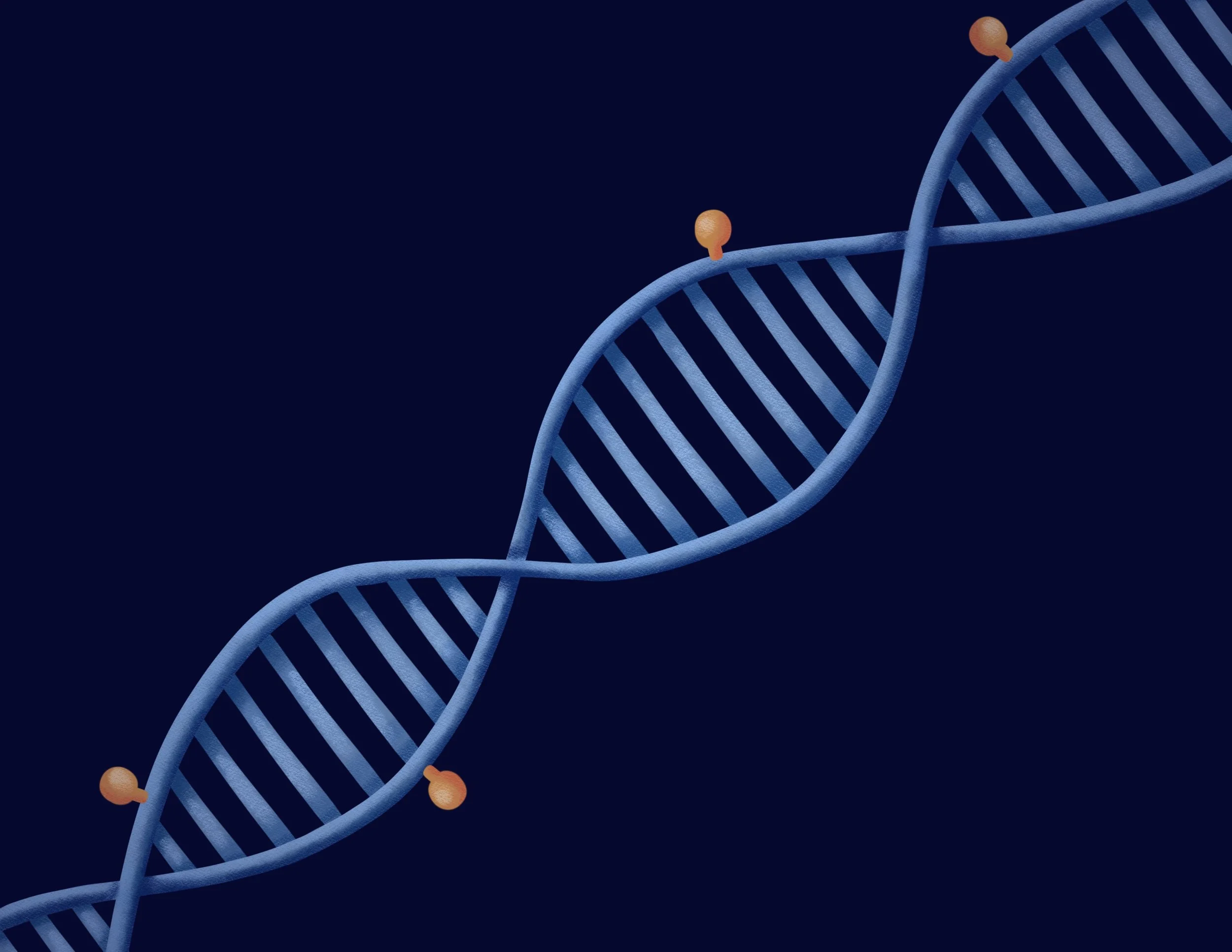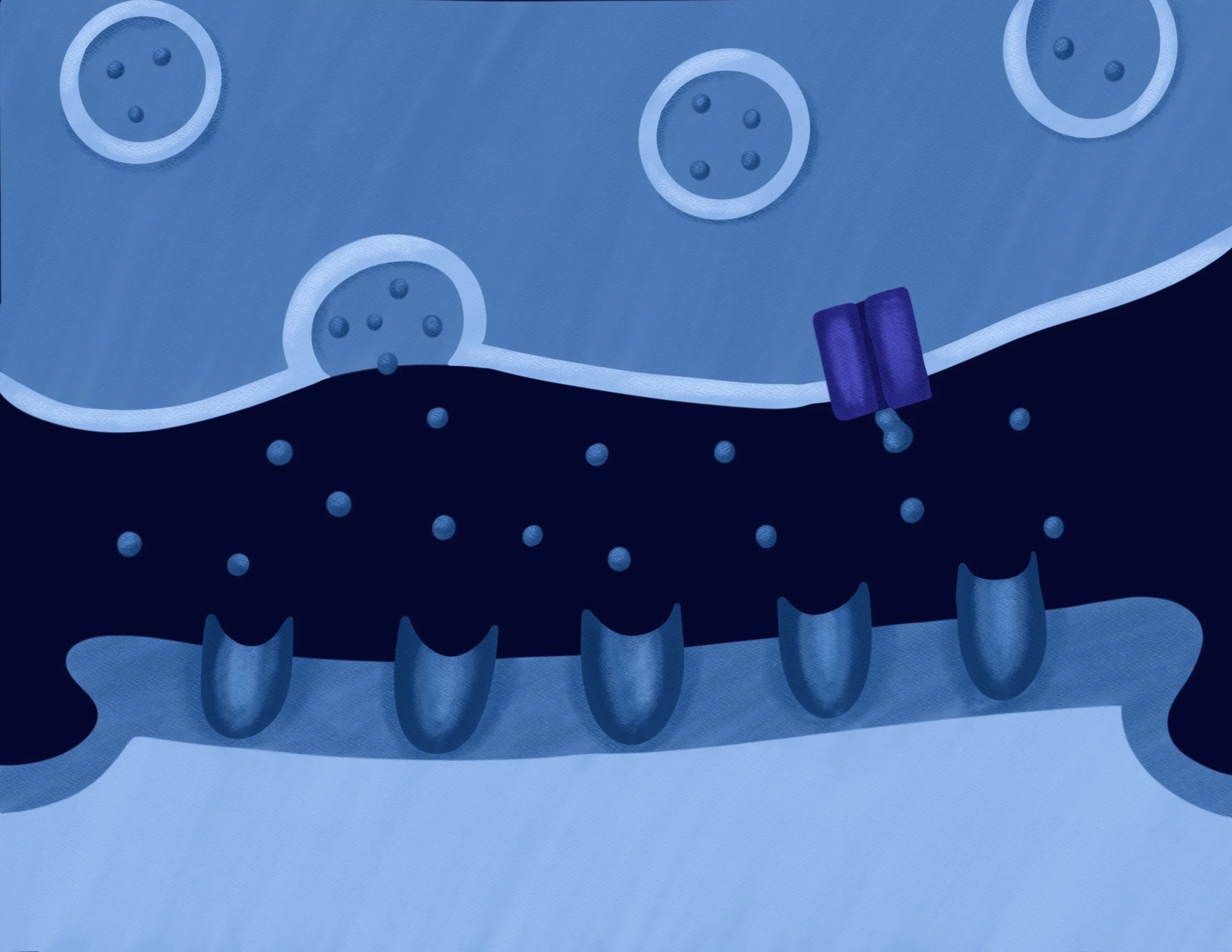The Epigenetics of Bipolar Disorder
Author: Ekta Arora || Scientific Reviewer: Alexis Tang || Lay Reviewer: Sami Kazi || General Editor: Rosmy Joseph
Artist: Rebecca Mascione || Graduate Scientific Reviewer: Claire Deckers
Publication Date: June 11th, 2025
Psychiatric conditions impact millions of individuals throughout the United States, yet many of their underlying mechanisms remain poorly understood. . Bipolar disorder (BD) is a chronic psychiatric disorder that affects a diverse population of patients. It is believed to manifest as the result of a complex interplay of the gene-environment model, which links the interactions of the genome, environment, and epigenetic marks [1]. Although bipolar disorder is thought to be primarily hereditary, or passed from parent to offspring, research suggests that it is highly dependent on both genetic predisposition and environmental triggers [1].
Individuals with bipolar disorder experience recurrent episodes of depression, mania, or mixed hypomania–a milder form of mania characterized by an elevated mood, activity, and energy that is atypical of the individual's baseline [2]. This disorder is classified into two categories: Bipolar I (manic and/or mixed episodes) and Bipolar II (depressed and/or hypomanic episodes) [2]. While both types share common symptoms, the primary distinction lies in the severity of the associated manic episodes. BD can be diagnosed at any age, with early, mid, and late-onset. The peak age of onset is 25 years old, with 70% of cases diagnosed at or before then. While more uncommon, late-onset BD diagnosis can also occur [2]. The data for late-onset diagnosis varies, as older adults may experience symptoms atypical of baseline diagnosis. Additionally, this diagnosis may be related to other factors, such as long-term access to healthcare and willingness to seek treatment [2].
A New Approach to Bipolar Treatment
In recent scientific advancements, researchers have shifted their focus to epigenetic factors that may influence gene expression in psychiatric disorders. Epigenetics involves the study of how environmental factors influence gene expression [3]. Epigenetic changes are distinct because they do not change the genome, but rather they alter a gene’s expression both reversibly and irreversibly [3]. While the gene’s sequence remains unaltered, its activity changes. DNA methylation is a well-known epigenetic modification, altering the production of mRNA, which is used to facilitate protein synthesis. Epigenetics play a fundamental role in how the body is altered by our surroundings and stresses the importance of considering the environment when diagnosing/treating psychiatric disorders. The epigenetic landscape can be altered by a variety of external factors and environmental stressors, like exposure to toxins, physical activity, stress, diet, and a wide variety of other lifestyle factors [4]. These environmental factors cause epigenetic modifications, including changes in DNA methylation: hypomethylation indicates lower methylation levels, and hypermethylation indicates heightened methylation levels [3].
DNA methylation refers to when a small chemical tag–a methyl group (CH₃)–attaches to a specific building block of DNA, called cytosine. This cytosine is often linked via a phosphodiester bond to another building block, such as guanine. Together, the cytosine and guanine building blocks form a region known as a CpG site [5]. A cluster of CpG sites, often referred to as CpG islands, can be found near promoter genes that help regulate how much protein a cell makes, therefore affecting its expression [5]. Normally, CpG islands remain unmethylated and their genes are active [5]. Through environmental stressors, these regions may become hypermethylated, effectively silencing associated genes [5]. Once a gene is methylated, methyl-binding proteins (MBP) bind and act as a signal for transcriptional corepressors [6]. This signaling process makes it harder for transcription factors, which are proteins that are essential to gene expression, to attach and promote gene activity. If transcription factors are unable to bind to a gene, then the gene is effectively silenced [6]. The silencing of specific target genes shows a high correlation with disease manifestation in bipolar patients. Researchers are currently investigating genes such as CACNA1C and SLC6A4, as their function directly correlates with neurobiological regulation. Both CACNA1C and SLC6A4 are found to be hypermethylated, and therefore silenced, in patients reporting symptoms of bipolar disorder [7, 8].
CACNA1C
CACNA1C is important because it encodes a protein that forms calcium channels [7]. Calcium channels are crucial for the membranes of heart muscles and neuron cells as they regulate the flow of calcium ions into and out of cells [9]. This regulated flow ensures adequate neural signaling. In the context of bipolar disorder, calcium channels are essential for mood regulation and the release of the neurotransmitters dopamine and serotonin, further highlighting the role of these calcium channels in neurological function [7]. Evidence has shown that a convincing number of patients with bipolar disorder have exhibited abnormal CACNA1C gene silencing, reducing production of these calcium channels [7]. CACNA1C hypermethylation has been linked to the development and earlier onset of bipolar disorder and has been found to be more prevalent in individuals of European ancestry [10]. In conjunction with environmental stressors that increase the rate of epigenetic change, the chances of developing BD symptoms increase.
SLC6A4
Additionally, the hypermethylation and silencing of the SLC6A4 gene dysregulates serotonin transport and reuptake within the brain [11]. The SLC6A4 gene synthesizes a serotonin transporter protein that is essential for the regulation of the serotonin reuptake system [11]. This system works by promoting reabsorption from the synaptic cleft, which is the small region between two communicating neurons [11]. This reabsorption process allows for the serotonin to be stored for future use and prevents elevated serotonin levels, thus preventing excessive signaling [11]. This dysregulation in serotonin signaling has been found to be more prevalent in individuals of East Asian ancestry [11]. Disruption of the SLC6A4 gene dysregulates the serotonin transport pathway, contributing to mood instability and bipolar disorder symptoms presentation. Due to the disruption, decreased synthesis of the serotonin transporter protein occurs and serotonin levels are increased.
The processes of calcium channel signaling and serotonin reuptake are fundamentally linked and reliant on one another. The proteins that SLC6A4 and CACNA1C produce work harmoniously within the brain of healthy individuals and are able to maintain a fine balance [12]. CACNA1C has the ability to impact serotonin levels as calcium channels regulate neurotransmitter release from neurons [12]. In conjunction, SLC6A4 affects calcium signaling as serotonin controls calcium-dependent neurotransmission [12]. The serotonin and calcium channel systems are linked by electrical coupling, which allows for the modulation of one another [12]. Hypermethylation of one or both of these genes can have serious negative effects on emotional regulation and cognitive function [12].
With improved understanding of the genetic and epigenetic processes of bipolar disorder, more focused research is required to find targets and effective treatment methods. Upon focusing on both the CACNA1C and SLC6A4 genes, a new door is opened to therapies that focus specifically on improving the compromised functions of both genes. In the case of CACNA1C, drug therapies may focus more on targeting calcium signaling by improving the function of calcium channels. Similarly, SLC6A4 may be targeted by drug therapies that improve serotonin transmission and restore serotonin balance within the brain. Through a deeper understanding of these mechanisms, researchers can aim to improve the functions of either one or both of these genes. Due to their linked nature, the improvement of one system (serotonin and/or calcium channeling) will positively impact the other [13]. Focusing on these functional changes can help providers minimize bipolar disorder symptoms and more effectively treat patients.
References
Comes, A. L., Czamara, D., Adorjan, K., Anderson-Schmidt, H., Andlauer, T. F. M., Budde, M., Gade, K., Hake, M., Kalman, J. L., Papiol, S., Reich-Erkelenz, D., Klöhn-Saghatolislam, F., Schaupp, S. K., Schulte, E. C., Senner, F., Juckel, G., Schmauß, M., Zimmermann, J., Reimer, J., & Reininghaus, E. (2020, February 2). The role of environmental stress and DNA methylation in the longitudinal course of bipolar disorder. International Journal of Bipolar Disorders, 8(1). https://doi.org/10.1186/s40345-019-0176-6
Jain, A., & Mitra, P. (2023, February 20). Bipolar Disorder. National Library of Medicine; StatPearls Publishing. https://www.ncbi.nlm.nih.gov/books/NBK558998/
Legrand, A., Iftimovici, A., Khayachi, A., & Chaumette, B. (2021). Epigenetics in bipolar disorder: a critical review of the literature. Psychiatric Genetics. https://journals.lww.com/psychgenetics/abstract/2021/02000/epigenetics_in_bipolar_disorder__a_critical_review.1.aspx
Alegría-Torres, J. A., Baccarelli, A., & Bollati, V. (2011). Epigenetics and Lifestyle. National Library of Medicine. https://www.ncbi.nlm.nih.gov/pmc/articles/PMC3752894/
Moore, L. D., Le, T., & Fan, G. (2012). DNA Methylation and Its Basic Function. Neuropsychopharmacology, 38(1). https://www.nature.com/articles/npp2012112
Miller, J. L., & Grant, P. A. (2019). The Role of DNA Methylation and Histone Modifications in Transcriptional Regulation in Humans. National Library of Medicine. https://www.ncbi.nlm.nih.gov/pmc/articles/PMC6611551/
Starnawska, A., Demontis, D., Pen, A., Hedemand, A., Nielsen, A. L., Staunstrup, N. H., Grove, J., Als, T. D., Jarram, A., O’Brien, N. L., Mors, O., McQuillin, A., Børglum, A. D., & Nyegaard, M. (2016). CACNA1C hypermethylation is associated with bipolar disorder. Translational Psychiatry. https://www.nature.com/articles/tp201699
Yang, Z., Zhang, S., Ouyang, L., Liao, A., He, Y., Li, Z., & Chen, X. (2023). DNA Methylation and Bipolar Disorder. Journal of Psychiatry and Brain Science. https://jpbs.hapres.com/htmls/JPBS_1555_Detail.html#:~:text=As%20an%20important%20epigenetic%20mechanism
Cooper, D., & Dimri, M. (2023, July 25). Biochemistry, Calcium Channels. National Library of Medicine; StatPearls Publishing. https://www.ncbi.nlm.nih.gov/books/NBK562198/
Scott, L. J., & Muglia, P (2009). Genome-wide association and meta-analysis of bipolar disorder in individuals of European ancestry. Proceedings of the National Academy of Sciences, 106(18), 7501–7506. https://doi.org/10.1073/pnas.0813386106
Ruchala, I., Cabra, V., Solis, E., Jr, Glennon, R. A., De Felice, L. J., & Eltit, J. M. (2014). Electrical coupling between the human serotonin transporter and voltage-gated Ca(2+) channels. Cell calcium, 56(1), 25–33. https://doi.org/10.1016/j.ceca.2014.04.003
Etain, B., Lajnef, M., Henrion, A., Dargél, A. A., Stertz, L., Kapczinski, F., Mathieu, F., Henry, C., Gard, S., Kahn, J. P., Leboyer, M., Jamain, S., & Bellivier, F. (2015). Interaction between SLC6A4 promoter variants and childhood trauma on the age at onset of bipolar disorders. National Library of Medicine, 5(1). https://doi.org/10.1038/srep16301
Harrison, P.J., Hall, N., Mould, A. et al. Cellular calcium in bipolar disorder: systematic review and meta-analysis. Mol Psychiatry 26, 4106–4116 (2021). https://doi.org/10.1038/s41380-019-0622-y





